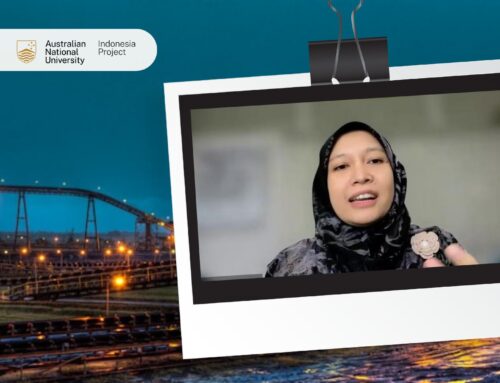In an attempt to contain the spread of the SARS-Cov-2 virus, social distancing has been the norm. With the COVID-19 pandemic fast crawling to every corner of the globe, social distancing needs to morph into stricter forms: self-isolation, house quarantine, territorial quarantine, and even lockdown. But enforcement, as it turns out, proves very complicated. The stampede in India is a case in point. As the health crisis turns into an economic crisis, most of the poor can not even afford to comply with distancing policies. In this webinar, the epidemiologist Pandu Riono from Universitas Indonesia talked about the social distancing intervention controversy in Indonesia. Manoj Pandey from ANU/UPNG discussed the pros and cons of lockdown policy in India. Finally, health and medicine scholar I Nyoman Sutarsa from ANU College of Health and Medicine discussed the implication of restriction policies to the poor and possible ways to balance the tension between public health risk and economic risk.
KEYPOINTS
• Physical distancing is required to flatten the curve of COVID-19 cases and related deaths. However, this is a very complex situation that requires proper modelling, planning, preparation and LEADERSHIP.
• In India, implementing a total lockdown has proven to be quite challenging with many adverse outcomes, in particular, the suffering of vulnerable groups.
• COVID-19 pandemic is a multi-dimensional crisis covering health, economic, social and political dimensions. This requires a multidiscipline and coordinated approach. Therefore, physical distancing should be very carefully considered in a way that allow marginalised groups to not having to choose between fulfilling their health, social, and economic needs.
SUMMARY
- To delay the spread of the SARS-COV-2 (COVID-19) virus, countries around the globe are enforcing physical distancing at varying degrees: self-isolation, house quarantine, territorial quarantine, total lockdown.
- The degree of physical distancing would largely affect the number of COVID-19 cases.
- In Pandu Riono and team’s model, with the current mild degree of social distancing, Indonesia might face more than 60,000 severe cases per day and more than 10,000 deaths per day at the peak of the pandemic. The number is far beyond the number of available respirators.
- However, with a high degree of social distancing, Indonesia might be able to push the number down to 10,000 severe cases per day with 2,500 deaths per day at the peak of the pandemic predicted in May.
- The actual number of COVID-19 cases in Indonesia is underreported, disregarded and overlooked. The reported cases are based only on lab-confirmed cases and Indonesia severely lacks the health and testing facilities to identify and to manage cases, particularly outside large capital cities.
- Current government policies in Indonesia in response to the pandemic have been poorly coordinated and full of conflicting messages and measures. There are delays in implementations with no clear strategy, and the public is led with misunderstandings and preconceptions.
- The model suggests that high-intensity social distancing along with mass screenings and strengthened health care systems are strongly needed for Indonesia. However, the multidimensional effects of physical distancing need to be considered very carefully, taking into accounts social safety nets especially for the poor and vulnerable.
- President Jokowi’s administration must take assertive and serious actions. For large scale nationwide social restrictions, there needs to be a coordinated effort led by the central government to be implemented together with the regional governments, especially during the upcoming Ramadan & Idul Fitri.
- Enforcing high-intensity social distancing, such as lockdown, is proven to be challenging, such as in the case of India with 21 days of complete lockdown.
- Immediately after lockdown is announced, India experienced a massive reverse migration of poor migrants. Chaos ensued as the poor had to choose between the probable death of COVID-19 or certain death of hunger coming from food-job-money uncertainty.
- After 3-4 days of lockdown, the government managed the massive reverse migration by providing transports. However, the risk of virus transmission to small towns/villages and increased deaths on the way home were not assessed properly.
- While currently the situation has stabilised, food-job-money security for the poor remains a major issue.
- Furthermore, with the lockdown, India is expected to experience adverse health and economic outcomes.
- Adverse health outcomes, including higher infant/child deaths, higher prevalence of malnutrition/hunger-related disease, higher vulnerability among the vulnerable groups (poor, elderly, pregnant women, and people with chronic disease), poorer mental health, a higher level of domestic violence.
- Adverse economic outcomes include food-job-money issue for the poor, closing of businesses from small shops to MSMEs, and fiscal pressure on the economy. Moreover, at a macro level, there would be a reduction in GDP growth, higher fiscal deficit, higher unemployment rates, higher NPAs, and increased food poverty.
- To reverse the outcomes, India may implement some policy options.
- Strengthening essential services with better provisioning, access, and mobility.
- Spending of up to 5 per cent of the GDP to ensure food, jobs and money for the high-risk or vulnerable population.
- Extending lockdown for two more weeks to better control the transmission of the virus while keeping humanitarian approach in mind.
- COVID-19 pandemic is a multi-dimensional crisis covering health, economic, social and political dimensions. As in the case of India, marginalised groups are suffering the most.
- As public health and economic measures are taken, they need to be tailored to ensure the protection of vulnerable groups.
- Social security programs need to be rolled out quickly with thorough consideration of the timing and method.
- Policies need to be well-coordinated to ensure the right groups are targeted and the limited resources are properly allocated.
- Existing community systems need to be considered in enabling sporadic actions
Please refer to the video and slides provided for the complete presentation. Unfortunately, Pandu Riono’s slides are not yet available for distribution.
Republished from ANU Indonesia Project




